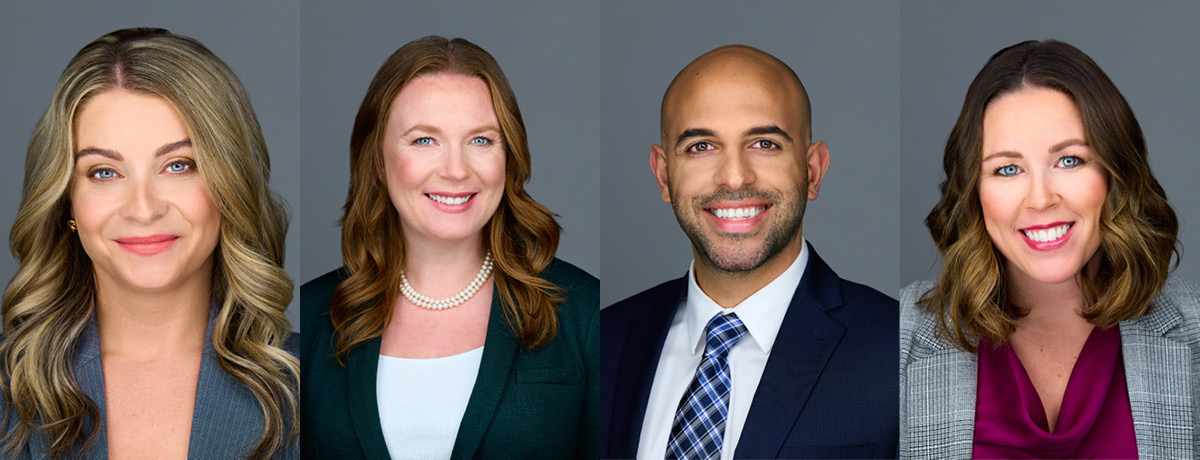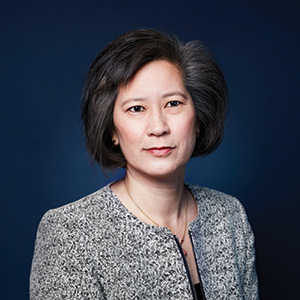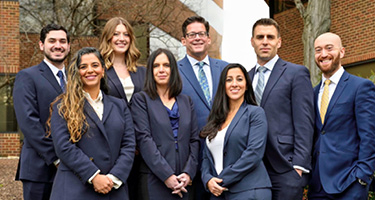The Oatley Vigmond effect, or as it is known in some quarters, the “OV premium,” refers to the fact that the firm’s reputation so proceeds it that the mere invocation of its name prompts insurance adjusters to reconsider the adequacy of their first offer in a claim.
This strong reputation, founded in the firm’s commitment to defending its clients’ best interests and agreeing to nothing less than a case’s true value, has been hard-won by the partners and lawyers who have made up Oatley Vigmond’s fierce advocacy team for more than 20 years.
Earlier this year, Oatley Vigmond sought to further ensure its legacy by naming Liane Brown, Lara Fitzgerald-Husek, Ben Irantalab and Karen Vigmond as the newest partners in its ranks.
On Making Partner
“It’s a rewarding feeling to be named partner,” says Fitzgerald-Husek. “It’s a recognition of the work I've done to assist clients over the years, and also the reputation that I have and continue to build for myself within the industry.”
For Brown, who first joined Oatley Vigmond while still in law school, it was always made clear to her that she had a long career ahead of her at the firm as long as she continued with her excellent work. “Being made partner is the culmination of many years of hard work. As lawyers, we’re all type A and goal-oriented, so this is finally reaching that goal.”
“It’s an acknowledgement of my work to date, so it feels amazing,” echoed Vigmond. “It’s also a recognition by the existing partners of my leadership skills and my ability to be a leader in the future. And to get that from those that you hold in such high esteem is really rewarding.”
Irantalab’s comments mirrored those of his colleagues, but he also noted the added responsibility that comes with a partnership role. “There is now even more of an expectation from us than there was as an associate,” he says. “So it's living up to that higher bar.”
On Winning Challenging Cases
This new cohort, however, is no stranger to responsibility or complex legal cases as, together, they have almost 40 years of experience in handling some of the firm’s most difficult files.
“There are so many different ways a case can be challenging,” explains Fitzgerald-Husek, who worked as defence counsel before making the leap to the other side. In discussing what it takes to meet such challenges, she noted the importance of marshalling evidence and being prepared. “First of all, it’s knowing that file inside and out, knowing those facts, knowing what your strengths and your weaknesses are. You can't hide from the weaknesses in your file. You've got to identify them, and then you have to understand how to inoculate against them. You need to know the angles from which the defence could come at you and how to anticipate those arguments and rebut them before they're even made.”
Each partner’s expansive experience has them well-equipped to handle any case they’re presented with. Among the most notable cases they’ve worked on, Irantalab is particularly proud of his work on the precedent-setting case of Perneroski v. Echelon Insurance, which is cited as Benson v. Belair Insurance after the Court of Appeal heard both appeals together. The circumstances of the case were especially tragic. Irantalab represented an Ontario man who was catastrophically injured while riding his dirt bike in the United States, leaving him in a wheelchair with the ability to communicate only by blinking. His Ontario insurer denied his claim, arguing that his vehicle was not an “automobile,” and he was therefore not entitled to statutory accident benefits. On virtually similar facts in Benson v. Belair Insurance, a FSCO Arbitrator, a FSCO Director’s Delegate and a three-judge panel of the Divisional Court had ruled in the insurer’s favour before Mr. Perneroski’s case went to court. This left Irantalab with an uphill battle of convincing a judge in a summary judgment motion to depart from the reasoning in Benson. Despite the legal challenges he faced, Irantalab was successful.
Setting the scene, he emphasized both the severity of his client’s injuries and the ensuing pressure to deliver him justice, as well as the heavy legal challenges they were up against. “We had three judges of the Divisional Court and two FSCO arbitrators essentially saying in Benson that our interpretation of the law was wrong. So we were faced with persuading the motion judge that three of her colleagues and two specialized arbitrators all got it wrong. Not only were we able to persuade the judge to depart from the reasoning in Benson, but when both appeals were heard together by the Ontario Court of Appeal, we succeeded in persuading the Court of Appeal to uphold the Perneroski decision and overturn the Divisional Court in Benson. When the Supreme Court of Canada denied leave to appeal, the interpretation of the law that we believed to be correct all along became the law in Ontario.”
Reflecting on her own past cases, Fitzgerald-Husek was quick to identify the Goliath-like challenges she faced in Kwok v. Abecassis. The difficulties in the case were multi-layered, starting with the fact that her client had been involved in two separate impacts while on a highway, which raised the question of whether there had been one accident or two. Reconstructing the scene to make this determination required monumental efforts in tracking down witnesses and the necessity of bringing a motion to admit the 911 calls into evidence for the truth of their contents. To add to the obstacles of the case, there was the issue of which of her client’s impairments were caused by which of the two impacts. The whole case was so complex, in fact, that the jury was struck because it was determined that it would be too difficult for the jurors to decide the matter.
“What was specifically challenging about that one was that we had to prove our case on both liability and damages,” she explained. “And it raised this really interesting legal argument as to whether there had been one versus two accidents. In turn, this required us to focus on proving there had been an unbroken chain of events which resulted in the two accidents being one collision under the law. So it definitely stands out as a more interesting case from a liability point of view.”
Ultimately, Fitzgerald-Husek was successful.
All four partners spoke of the emotional challenges they face with certain cases, most notably those involving children or fatalities. For Brown, one of her more memorable cases involved the death of a mother of three who was killed on Christmas Eve while trying to pay for parking after visiting a relative in the hospital. Brown noted that, from the very start, she knew it was going to be a difficult case because of its particularities. “It was a very difficult liability situation,” she explained. “The insurance company denied the claim because they took the position that she was the author of her own misfortune. We had to get extensive engineering reports to establish that the parking lot exit had effectively been designed improperly. It was a hidden trap waiting to happen. Ultimately, we were able to negotiate a very significant settlement for the husband and their three children. But it was a very difficult case that settled really close to trial.”
The reality in personal injury law, as noted by all four lawyers, is that approximately 99% of the firm’s cases are settled out of court. Vigmond explained that this relates to a combination of the stress of the litigation for the client, delays in the system and inherent risks in certain files, although fact-specific to each case. Thus, for Vigmond, the cases that stand out most in her mind are often those that settle, noting that in many instances, they may be challenging on the facts in themselves or may involve delving into cases that require intimate knowledge of expert territory.
Vigmond also spoke of the particular difficulties that arise in certain medical malpractice cases. “I've been involved in delayed cancer diagnosis cases and those can be very challenging because of causation, where you have to sort out whether the damages were caused by the delay or the disease itself. There is also the issue of birth injuries, where the cases are very challenging because you're dealing with causation and establishing what a doctor did or did not do that could have changed the outcome.” Vigmond also reflected on another interesting case in which an elevator malfunctioned and hit her client in the head. “So again, you have to have an understanding of the plenitude of technical standards and have an understanding from an engineering standpoint in terms of how elevators work, how they can malfunction and how that caused the injury, and then being able to distil that down to a jury.
A Rewarding Profession
Although the four newest Oatley Vigmond partners are quick to set out the cases that have challenged them the most, they are perhaps even quicker at noting the rewards of their chosen profession.
There is no question that Brown, Fitzgerald-Husek, Irantalab and Vigmond are experienced, skilful and powerful litigators and negotiators. Yet, each one of them softens when discussing the impact they make in their clients’ lives. “Of course, there are those sleepless nights, where I constantly think about a case,” Irantalab says. “But, if you do succeed and get that positive result for your client, there is no better feeling.”
“In the end, it’s really about being able to help a client successfully resolve a claim and helping them close that chapter in their lives,” Fitzgerald-Husek observed. “Throughout a file, you see people grow, you see recovery. And it’s wonderful to know you’ve done the best you could to help them move forward.”
Into the Future
Each partner’s plan for the future at the firm also involves a feeling of ever-evolving growth and momentum. Both Irantalab and Vigmond spoke of using their new role as partner to take on even more challenging cases and, where appropriate, taking them to trial, getting reported decisions, and growing their names as lawyers within the industry and the firm, as well as continuing to get the best results for their clients. Fitzgerald-Husek is looking forward to working on cases involving advancements in technology and, in particular, focussing on the interesting crossover between ethics, technology and law that will likely arise with the increased use of self-driving cars. As for Brown, she spoke of her recent appointment as a board member with the Ontario Trial Lawyers Association and the opportunity it will present to contribute to the organization’s lobbying efforts in affecting personal injury law and policy in the province.
In any case, the OV premium seems safely secure.






























